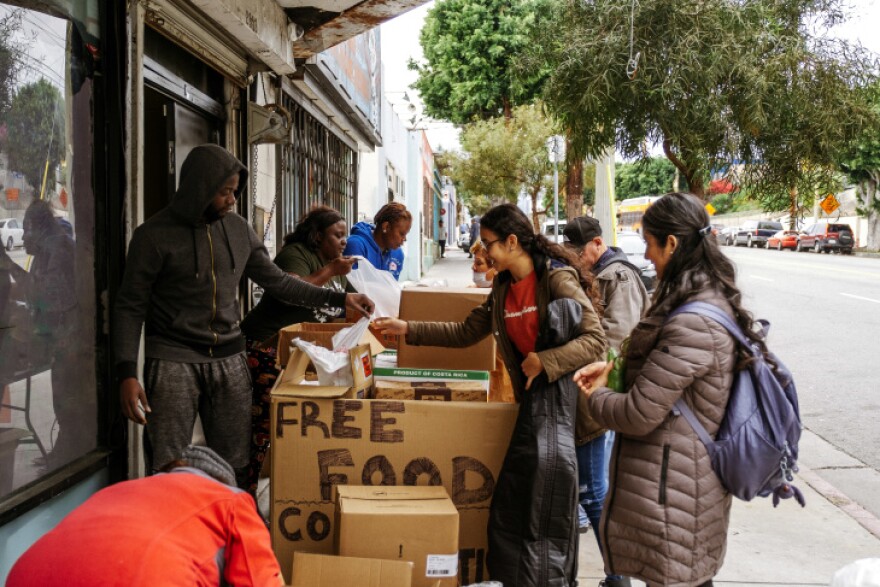Truth matters. Community matters. Your support makes both possible. LAist is one of the few places where news remains independent and free from political and corporate influence. Stand up for truth and for LAist. Make your year-end tax-deductible gift now.
Food Insecurity In LA County Is Getting Worse, Not Better, Study Finds

This Thanksgiving Day, we're taking a look at a serious issue plaguing Los Angeles: food insecurity.
A recent report from USC suggests things have been getting worse in Los Angeles County over the past few years, and that 3 out of every 10 households now struggle to put enough food on the table.
That number goes up to more than 4 in 10 among low-income residents, who are experiencing the worst food insecurity in a decade.
LAist 89.3 host Sharon McNary spoke with Kayla de la Haye, scientist and director of USC's Institute for Food System Equity about food insecurity in L.A., about why the numbers are worse now than at the height of the pandemic and what needs to change. The following interview has been edited slightly for clarity and length.
Can you define food insecurity for us?
Food insecurity is when people don't have enough food to eat. They lack the money or resources needed to get all the food they need for their household.
And why is it on the rise in L.A. County?
It's going up nationally, but we've seen a really big spike in L.A. County since 2022. And the numbers this year, in 2023, are the highest we've seen in a decade because of a number of things, [including] drops in benefits to pandemic era programs. So folks are getting less money for food stamps than they did before. That's happening at the same time when food prices are really high and cost of living is really high, and people just aren't able to make their budget stretch to get the food that they need.
Your recent study found that food insecurity for low-income households is worse now than during the pandemic. Can you describe what resources were there during the pandemic and why they've gone away?
Yeah, we've seen alarming rates of food insecurity in our data — when the pandemic hit, among low-income households in particular — and currently we're seeing 44% of low-income households in L. A. County that are food insecure. That is higher than we've ever seen during the pandemic.
When the pandemic hit, folks got a boost to their CalFresh benefits, also known as food stamps, and those ended in March 2023. So for the average household in L. A. County at the end of 2022, they were getting about $470 a month in food benefits. [And] by July 2023, they were getting less than $300 a month in benefits, because the pandemic era boost was terminated.
Did the money for low-income children going away after the pandemic also reduce what's available in the household?
Yeah, when we talk to families who have experienced food insecurity, [we're hearing] that the drop in a bunch of benefits — the child tax credit, pandemic EBT, these extra boosts to their food benefits — a lot of things dropped off in the last few months. And folks are really struggling to make their budgets work with all of the rollback on those benefits.
So demographically, which communities are we seeing most suffering from hunger and lack of access to food?
We are seeing rates that are about two times higher among Black and Latino households compared to white households. Over the last few years, those communities of color were really impacted by this a lot more than others. We're also seeing women being more affected than men. Younger adults under 40 have been really vulnerable to food insecurity. And about one in four of these households have kids in them.
What about solutions? What is it going to take to get these numbers back down?
What we know is that there is no silver bullet solution. There's no one thing that is going to fix this. And it really requires a bunch of different sectors working together to really strengthen our whole food system in L.A. County to make sure that healthy food is available to everyone, that it's affordable, that it's in places in people's communities where they can access it.
So we're really supportive of the county's Food Equity Roundtable efforts that lay out a really comprehensive strategic plan, not just to put a Band Aid on food insecurity.
We don't want to be here every Thanksgiving talking about how many folks are having to line up to food pantries to get the food they need. So what we think is needed is really a long-term change in our food system to really help people in a wealthy country like the U.S. be able to get access to affordable, healthy food.
What would you tell our listeners who may be wondering what they individually can do to help?
Individually, you can support your governments in making these big changes to our food system. And what you could do this weekend or this week is support your local food banks, because while we make some bigger long-term changes, there's a huge immediate need right now. And there are folks that just need food, and our emergency food assistance and food pantries are really the ones at the front line helping people out while there's this gap in their need.








